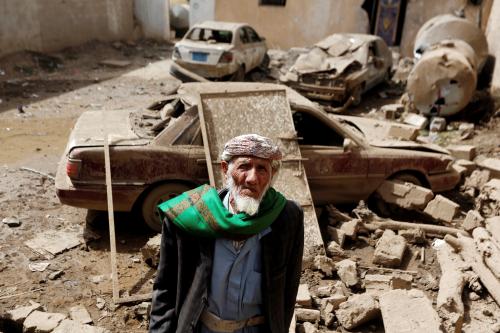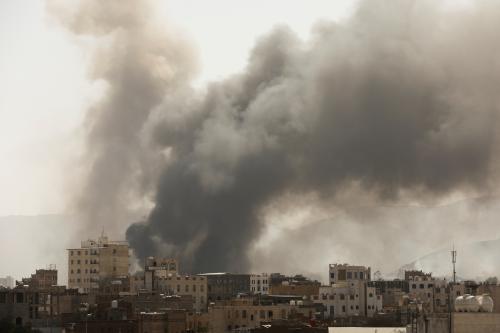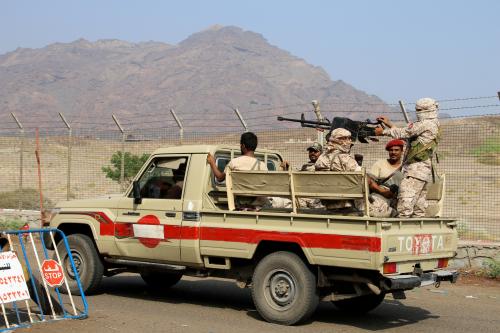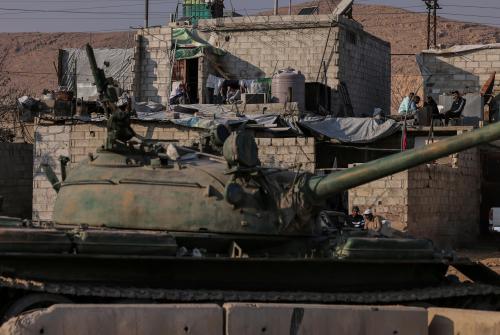This essay is part of the “Development, governance, and security in the Middle East: Obstacles and opportunities” project, a series examining how governance failures in the Middle East and North Africa have hindered stable development and human security, in partnership with the Japan International Cooperation Agency.
The regional dimension of the years-long war in Yemen has attracted much attention, whether because of Saudi Arabia’s bombing campaign or, more recently, the Iran-backed Houthis’ attacks against maritime shipping in the Red Sea. The negative domestic implications of the regional competition for influence in Yemen, however, have too often been neglected. The objective of this paper is therefore to explore how external intervention by Saudi Arabia, the United Arab Emirates (UAE), and the Islamic Republic of Iran has affected political and economic development as well as human security in Yemen.
To do so, the paper starts with a brief background section on the recent history of Yemen. It follows with an overview of the interests and policies of the three key regional states intervening in Yemen: Saudi Arabia, the UAE, and Iran. It then analyzes the negative consequences that external intervention has had on political and economic development and on human security in Yemen. In practice, it is difficult to neatly disentangle the causal effect of an external driver of instability, competition for influence by regional powers, from the effect of Yemen’s multiple domestic challenges. This is especially the case given the salience of the domestic sources of the war in Yemen: the conflict was initially a civil war, driven by competition for power and resources within a fragmented state. Nevertheless, external intervention has fueled the conflict, adding layers of complexity and exacerbating existing fault lines.
Background
The recent history of Yemen is marked by violence and war. In 1962, republican forces supported by Egypt overthrew the Saudi-backed imamate, a theocratic kingdom that had ruled parts of northern Yemen on and off for about 1,000 years, launching a brutal civil war. Out of the ashes of the war, Yemen emerged split. In the north, the Republic of Yemen remained poor and unstable, ruled by a succession of presidents until Ali Abdullah Saleh seized power in 1978. Based in Aden, the southern metropolis, the Popular Democratic Republic of Yemen, often known as South Yemen, was the Arab world’s only Marxist state. The collapse of the Soviet bloc cost it its main source of external support, leading north and south to agree to reunification in 1990. Yet the marriage was an unhappy one, widely perceived in the south as a brutal takeover by the north.
While discontent was brewing in the south, it was also growing in the north among Yemen’s Zaydi population. The Zaydi are a small minority within Shia Islam overall, but they represent about 35% to 40% of Yemen’s population, with the rest being Sunni. They are, moreover, found almost only in northwest Yemen. After the civil war, many Zaydis became increasingly frustrated at what they perceived as their political, economic, and cultural marginalization at the hands of the republican government in Sanaa. This frustration was especially strong among the Sada, families who claim descent from the Prophet and who had traditionally held dominant social, political, and religious roles in the imamate. One such family, the Houthis, seized control of this mobilization, building up the political and military strength of the nascent movement. Tension rose until it exploded into six rounds of fighting between 2004 and 2010, known as the Saada wars in the name of the Houthis’ northwestern stronghold.
In 2011, popular protests sweeping across the Arab world reached Yemen and, after months of instability, led to a United Nations-brokered deal backed by the United States and Saudi Arabia in November that saw President Saleh cede power to his vice president, Abed Rabbo Mansour Hadi. The U.N.-brokered deal led to a national dialogue in 2012-2013, with the aim of drafting a new constitution. After early signs of hope, however, the process collapsed under the weight of the country’s multiple fault lines. The Houthis, who had been consolidating power in the northwest and who felt marginalized by the dialogue’s proposed outcomes, stormed out of their stronghold and—with help from Saleh and his loyalists, with whom the Houthis had struck a temporary alliance based on their common opposition to the new order—seized Sanaa, the capital, in July 2014 and expelled the internationally recognized government.
In March 2015, Saudi Arabia launched a military intervention at the head of a coalition of 10 mostly Arab and Sunni states. Of those, only the UAE played more than a marginal military role. The coalition officially had two objectives: to roll back Houthi gains and reinstate Hadi’s internationally recognized government. By the early 2020s, however, after years of brutal fighting, the Saudi leadership had come to realize that the war was costly and that it could not achieve its objectives. As of early 2025, it is reasonable to conclude that a Houthi victory has occurred, even if not a total one. The Houthis do not control the entire country, but they do control one-third of its territory with key cities, including the capital, and two-thirds of its population. Most crucially, the Houthis have emerged as the most powerful political and military actor in Yemen. Anti-Houthi forces, in particular the internationally recognized government, remain much weaker and riven by divisions.
That is why Riyadh committed to a political process to negotiate an end to its participation in the war. As an interim step, this led in April 2022 to a six-month truce. Negotiations to extend it beyond October 2022 failed, though violence has remained broadly contained since. Saudi Arabia also announced in April 2022 that Hadi was stepping aside and that he was to be replaced by a Presidential Leadership Council composed of eight individuals, balancing pro-Saudi and pro-Emirati factions. Talks to make further progress toward a formal end to Saudi involvement stalled, however, in large part because of intransigence by the Houthis, who correctly perceive that they have emerged as the dominant political and military actor in Yemen and have been constantly expanding the demands they are trying to impose on the Saudis.
The October 7, 2023, attack by Hamas and the war in Gaza that followed opened a new set of opportunities for the increasingly powerful and ambitious Houthis to expand their regional role beyond Yemen’s borders. Demonstrating the growing range of their missile and drone arsenal, much of which had been assembled thanks to Iranian support, the Houthis directly targeted Israel for the first time in the fall of 2023. They followed with attacks against maritime shipping in the Red Sea and the Gulf of Aden, causing traffic to drop by about two-thirds. This led the United States and the United Kingdom to launch air strikes in January 2024 to try to compel the Houthis to cease the attacks, with little success.
External involvement in Yemen: Saudi Arabia, the UAE, and Iran
Saudi Arabia
Historically, Saudi Arabia’s interest in its southern neighbor has been to avoid either the extreme of a strong Yemen (which could threaten its hegemony on the Arabian Peninsula) or of a weak Yemen (from which insecurity could spill over northward). Following Yemen’s reunification in 1990, Riyadh briefly feared the former, the prospect of a strong, united Yemen. But as the country steadily drifted toward greater fragility over the following two decades, Riyadh’s focus was mostly on containing insecurity, notably as the Yemen-based al-Qaida in the Arabian Peninsula (AQAP) emerged as one of the group’s most dangerous branches.
The seizure of Sanaa by the Houthis in 2014 and the rapid collapse of the internationally recognized government led to a swing of the pendulum: for the first time in decades, Saudi Arabia faced the prospect of a strong and hostile actor on its southwestern border, one supported by its main foe, the Islamic Republic of Iran. The Saudi-led coalition, however, failed to achieve its two objectives of rolling back Houthi gains and reinstating the internationally recognized government in Sanaa. Once launched, Saudi-Houthi talks were making painfully slow progress, until they were sidetracked by the war in Gaza and the Houthis’ attacks on maritime shipping. The challenge that Riyadh faced before October 7, 2023, and that it will face even more in the future, is that the Houthis perceive, correctly, that they are dominant on the ground in Yemen and that Saudi Arabia acutely wants to avoid the return of regular Houthi missile and drone attacks on its territory, as regularly happened in earlier years of the war.
Looking forward, this means that Saudi hands are tied. Riyadh fears the emergence of the Houthis as a regional power, but it also realizes that the Houthis hold much leverage, which they have not hesitated to use to try to extract more concessions. This fear of Houthi retaliation also explains why Saudi Arabia, even though it has been watching with high levels of anxiety as the Houthis launched attacks and obstructed maritime traffic in the Red Sea, has kept a low profile and has refused to actively participate in U.S.-led operations to counter the Houthis.
The UAE
When it decided to join the Saudi-led coalition in 2015, the UAE had several objectives. Like Saudi Arabia, it was concerned with Houthi gains and how they could strengthen Iranian influence on the Arabian Peninsula. At the same time, the UAE sought to position itself as a reliable counterterrorism partner for the United States in its efforts against AQAP. A core objective of UAE foreign policy in general is also to counter the Muslim Brotherhood, which it sees as a threat to its regime’s legitimacy. In Yemen, this has translated into fierce opposition to Islah, a political party that is a broad coalition of Islamist, tribal, and business interests loosely aligned with the Brotherhood. Finally, the UAE has also sought to build a presence in the south of Yemen as part of its broader strategy of building influence in maritime areas around the Arabian Peninsula. Concretely, this has translated into support for the separatist Southern Transitional Council. The result so far has been, mostly, a success for the UAE: it is now the dominant external actor in the south.
To some extent, Emirati perceptions of the Red Sea crisis mirror those of Saudi Arabia, with some nuances. Broadly, the emergence of the Houthis as a regional power is a major source of anxiety. Houthi attacks against shipping in the Red Sea and the Gulf of Aden pose an especially acute threat to its economy, which is highly dependent on maritime trade. Yet, similarly to Saudi Arabia, the UAE has kept a fairly low profile and has refrained from participating in U.S.-led maritime or air operations. Like Saudi Arabia, the UAE fears Houthi retaliation, which severely constrains its options. The UAE is a trading nation whose brand is premised on an image of stability and predictability in the middle of a chaotic region. UAE-backed militias in the south are effective and could potentially challenge the Houthis. However, the threat of Houthi retaliation on critical infrastructure or skyscrapers in Dubai or Abu Dhabi compels the UAE to hold them back.
Emirati objectives in Yemen moving forward are not entirely clear. At a minimum, Abu Dhabi will want to consolidate its influence in the south and continue countering Islah and cooperating with the United States as its counterterrorism partner of choice. That said, there remains much uncertainty as to what exactly this means. The UAE, in particular, has never taken a clear public stance in favor of southern separation, even as it arms and supports the Southern Transitional Council. This ambiguity has so far allowed the UAE to build a strong influence network in the south while punting the issue of its support for an eventual formal move toward independence by the south. But at some point, if or when the UAE-backed Southern Transitional Council makes clear moves toward independence, this ambiguity will be increasingly unsustainable and will cause further tension with Saudi Arabia.
Iran
The Islamic Republic of Iran started developing links to the Houthi movement in the 1980s and 1990s, but in those early years, these were marginal. Iran possibly started providing limited amounts of small weapons and ammunition to the Houthis around the time of their fifth round of fighting with the central government in 2009, known as the Saada wars. From Tehran’s perspective, the Houthis were an appealing, if still marginal, partner: an armed group opposed to Saudi Arabia and sharing with the Islamic Republic a dissatisfaction with the regional status quo. Iran’s support for the Houthis steadily grew over the following years, especially as the Houthis seized the opportunity presented by the chaos that followed the uprising of 2011 to expand their influence in the northwest, which led Tehran to see them as an increasingly attractive partner.
Iran’s support for the Houthis ramped up after 2015 and the launch of the Saudi-led intervention because Iran saw an opportunity to contribute to its Saudi rival getting bogged down in a costly war. Iran increased its provision of small arms and ammunition and also started providing more advanced support. This included parts for missiles and drones as well as the advice, training, and intelligence necessary to assemble and use them. Iran also provided weapons and parts that have been essential for the Houthis’ attacks in the Red Sea, notably for underwater and surface drones, shore-to-sea missiles, and naval mines.
Iranian support, notably missiles and drones, has provided the Houthis with the ability to severely constrain the Saudi and Emirati margin of maneuver. That said, as much as Iranian support has been essential to explain Houthi successes, it is only half the story: a significant proportion of Houthi power has been generated locally, notably by absorbing units of the former Yemeni army and security services and making deals with tribal militias. In addition, Houthi successes have been facilitated as much by their adversaries’ relative weakness as by their own strength: the internationally recognized government has been unable to unify its disparate factions, who agree on little beyond their opposition to the Houthis. The Houthis, moreover, face severe vulnerabilities, despite their recent successes: the economic situation in territories they control is very difficult, in particular, while there are grumblings of opposition to their brutal rule.
The outcome that Tehran desires is the long-term consolidation and legitimation of Houthi power.
The Houthis’ rapid emergence as a regional power after the October 7 attacks and the Houthis’ actions in the Red Sea have provided the Islamic Republic with a clear net gain. For a limited investment—it is impossible to quantify it based on publicly available data, but it is at most in the low hundreds of millions of dollars on an annual basis—Iran has facilitated the rise of a new key player that can now help project Iranian influence in and around the Arabian Peninsula. The Houthis are not a proxy of Iran—if the term is defined narrowly as an arm of the Islamic Republic’s foreign policy that obeys its commands. Instead, they are a fiercely nationalist group that jealously guards its autonomy. That said, their interests are closely aligned with those of Tehran, and both gladly work together in their pursuit. Moving forward, Iran supports the political process in Yemen, not because it wants national unity or peace but because it correctly perceives that the Houthis have emerged from the war as dominant. The outcome that Tehran desires is, therefore, the long-term consolidation and legitimation of Houthi power.
The domestic consequences of external intervention in Yemen
External intervention has had negative consequences for Yemen’s political and economic development as well as for its human security. Building on the previous one, this section dissects how the competition for influence between Saudi Arabia, the UAE, and Iran has affected Yemen.
Political development
The war’s regionalization has had multiple consequences for Yemeni political development, with two standing out: how Iranian support has boosted the Houthis’ fortunes, and therefore facilitated the entrenchment of their increasingly authoritarian and repressive rule, and how Saudi-Emirati competition has encouraged the fragmentation of the internationally recognized government and stymied the consolidation of anti-Houthi forces into a more unified bloc.
The war has seen the Houthis’ emergence as the de facto governing authority in northwest Yemen, in good part thanks to Iranian support. Houthi governance has become highly repressive, corrupt, and obscurantist, a trend that has intensified as hardliners in the group have consolidated their control. There is no space for political dissent; they have harassed and jailed journalists and activists, and several cases of torture have been documented. They have imposed intensifying gender segregation: there are, for example, far fewer women occupying senior positions in the bureaucracy or the judiciary than before 2014, while they have imposed restrictions on women’s freedom of movement. The Houthis have steadily militarized society, for example, by running summer camps for children that offer them basic training and ideological indoctrination. They are also steadily revamping education curricula to prioritize teachings aligned with Houthi ideology.
The Gaza war and the Red Sea crisis then further opened an opportunity for the Houthis to entrench their rule and clamp down on dissent. In fact, the war in Gaza helped them increase recruitment by mobilizing strong pro-Palestinian feelings among Yemenis. It has also provided them with a pretext to arrest civil society activists and opponents, casting those suspected of opposing them as pro-U.S. or pro-Israel fifth columns. Starting in late May 2024, in particular, the Houthis launched a crackdown on local personnel from international and non-government organizations, including the U.N., arresting and jailing dozens and accusing some of espionage.
The Houthis have also benefitted from the internationally recognized government’s weakness. Saudi Arabia tried to improve the unity of anti-Houthi forces in 2022 when it pushed Hadi aside and established a Presidential Leadership Council to bring together eight individuals representing key factions (four of them are close to Saudi Arabia, and the other four are close to the UAE). The internationally recognized government’s weakness is primarily the result of domestic factors: the Presidential Leadership Council is a heterogeneous coalition bringing together actors with little else in common than their opposition to the Houthis. Several had been rivals prior to 2014, and they have not been able to build a strong common front.
That said, Saudi-Emirati competition has exacerbated this fragmentation. Riyadh and Abu Dhabi, in particular, have often supported and armed individual factions instead of pushing harder for the formation of a unified chain of command. The UAE has provided support for the Southern Transitional Council, which has a separatist agenda and difficult relations with several factions within the Presidential Leadership Council. Abu Dhabi also opposes the Saudi-backed Islah, one of the most powerful anti-Houthi factions, because of its ties with the Muslim Brotherhood. Saudi Arabia has responded by trying to prop up other groups in the south, notably in the eastern province of Hadramout, that it hopes will act as counterweights against the Southern Transitional Council. This has only exacerbated existing divisions within the internationally recognized government, which has been decisive in paving the way for the Houthis’ victory.
Economic development
Yemen’s economy has collapsed in recent years. It was already the poorest country in the Arab world prior to the uprising of 2011, at which time levels of development were comparable to those in the Gaza Strip. War has made the situation worse; external intervention is, here again, not the sole cause but an important compounding factor.
The Houthis have shown themselves to be poor stewards of the economy, with their policies, mismanagement, cronyism, and corruption exacerbating already difficult conditions. They have seized assets linked to the internationally recognized government and redistributed them to loyalists, imposed strict measures on the banking and financial sectors aligned with their interpretation of Islamic law, and increased their control over the private sector in general. The Houthis have also failed to regularly pay the salaries of civil servants, leading to growing discontent in areas under their control.
Yemen’s financial system, already weak, has been devastated by a decade of war. The ongoing dispute around the Central Bank of Yemen illustrates how war has damaged the economy. In the wake of the Houthis’ seizure of Sanaa in 2014, the central bank eventually split in two, with one based in Aden and another in Sanaa. Both have since competed for control over monetary policy and cash flows. The situation escalated in 2024 when the government-aligned Central Bank of Yemen-Aden announced a plan to launch a unified money transfer system to track and control payments. This was consistent with the internationally recognized government’s strategy of trying to economically isolate the Houthis and force banks and businesses out of Houthi-controlled territory. In response, the Houthi-aligned central bank in Sanaa announced that it would issue its own coinage, threatening to entrench the financial division between Houthi and government-controlled parts of the country.
In July 2024, the Aden-based central bank further escalated the conflict when it ordered Yemeni banks to move their headquarters from Sanaa within 60 days and revoked the licenses of six Sanaa-based banks. It also imposed additional controls on local and international money transfer networks. In response, the Houthis threatened to strike Saudi Arabia directly. Fearing a return of Houthi attacks above all else, Riyadh pressured the internationally recognized government to back away, even suggesting that it would not come to its assistance should the Houthis attack. The internationally recognized government rapidly ceded to the pressure, reversing the Aden central bank’s decisions.
The Houthis, dominant and unchallenged in the northwest, can systematically exploit divisions among the anti-Houthi camp as well as the vulnerabilities of its external Saudi and Emirati backers.
Fearing further escalation, the U.N. brokered an agreement that led not only to an end to the measures against Sanaa-based banks but also to an agreement to increase flights to and from Sanaa, a long-standing Houthi request. The clear takeaway from this episode was that the Houthis, dominant and unchallenged in the northwest, can systematically exploit divisions among the anti-Houthi camp as well as the vulnerabilities of its external Saudi and Emirati backers. Inevitably, this consolidates the Houthis’ power and further emboldens them.
Beyond the central bank dispute, war and external intervention have damaged the country’s economy in myriad ways. Houthi attacks on maritime shipping in the Red Sea, for example, have forced a reduction of traffic in the main port on Yemen’s western coast, Hodeidah. Israeli strikes, especially powerful ones in September 2024, have further damaged the port, through which a significant proportion of humanitarian assistance comes in. In addition, while Yemen has never been an important hydrocarbon producer, war has damaged the country’s already limited ability to export oil and gas. The Houthis, in particular, have targeted oil and gas infrastructure in areas not under their control and have threatened to do so again should the internationally recognized government try to resume exports.
Human security
Yemen has been afflicted by one of the world’s worst humanitarian crises. According to the United Nations Office for the Coordination of Humanitarian Affairs, more than 19 million Yemenis are in need of humanitarian assistance as of January 2025. The education and health care systems, already weak before 2014, have nearly completely collapsed. The country has seen more than 2.5 million suspected cases of cholera, while nearly half of all children under five are acutely malnourished. More than 4.5 million people remain internally displaced because of violence. This insecurity has a strong gender dimension: more than 6 million Yemeni women and girls are at heightened risk of gender-based violence. Women and girls from minorities, such as the Muhammasheen (a visible minority that has been historically marginalized), are especially at risk.
The difficult security situation in Yemen makes the delivery of humanitarian assistance challenging. Poor infrastructure and a harsh mountainous terrain in the northwest and desert in the east compound these challenges. That said, the delivery of humanitarian assistance has also been particularly hampered by the Houthis, who have created a body, the Supreme Council for Management and Coordination of Humanitarian Affairs and International Cooperation, to allow them to tighten their grip on aid organizations. Houthi authorities frequently deny permission to aid organizations to reach certain areas. They have also systematically diverted aid to their supporters. During the COVID-19 pandemic, Houthi authorities imposed severe restrictions on international aid agencies and humanitarian organizations, hampering their ability to provide care to Yemenis. According to Human Rights Watch, the Houthis also blocked shipments of medical equipment, tried to use them as bargaining chips, and attempted to divert aid to loyalists. Moreover, the new Trump administration designated the Houthis as a Foreign Terrorist Organization in January 2025. While this will provide the United States with additional tools to counter the Houthis, it will also further constrain the already difficult delivery of humanitarian assistance in Houthi-controlled areas.
The Houthis have also extensively recruited child soldiers, including some as young as 13. The precise number of children in Houthi ranks is unclear, but according to Human Rights Watch, it numbers in the thousands. One Yemeni civil society organization, for example, has estimated the number at more than 10,000 between 2014 and 2021, documenting the names of 111 children killed in battle in July and August 2020 alone. According to a study by the Sana’a Center for Strategic Studies, economic factors have been one of the main drivers of child recruitment for Houthi and other militias, given the country’s widespread poverty. Other drivers include “revenge, patriotism, ideology, religion, tribal duty, and a lack of educational opportunities.” According to Human Rights Watch, the recruitment of child soldiers by the Houthis further intensified after October 7, 2023, as part of their drive to exploit the crisis to boost mobilization. Of note, other groups, including some aligned with the internationally recognized government, have also recruited child soldiers, but on a smaller scale.
Years of war have also imposed an increasingly heavy burden on the environmental front. This has been made even more acute by the impacts of climate change, creating a feedback loop whereby environmental challenges fuel conflict, which in turn exacerbates authorities’ inability to address environmental problems. Yemen, for example, is one of the most water-poor countries in the world. Water scarcity has for decades contributed to local conflict, while state weakness, mismanagement, and corruption have systematically stymied efforts to alleviate these challenges. More recently, war and climate change have further compounded the problem. Climate change has also led to changing rainfall patterns which, again in combination with decades of war and mismanagement, threaten agricultural productivity in a country that is already not self-sufficient in food. This has, again, disproportionately affected women and vulnerable groups.
Reports also suggest that climate change is leading to an increase in the frequency and velocity of storms in parts of Yemen. Heavy floods in the summer of 2024 illustrate the consequences of this nexus between the environment, insecurity, and government dysfunction. Torrential rains and flash floods in different parts of the country, notably in the mountains west of Sanaa, Hodeidah on the west coast, and Marib in the center, killed nearly 100 people, damaging or destroying at least 50,000 homes, exacerbating already acute food insecurity, and forcing the displacement of thousands of families.
Conclusion
It is essential to avoid the analytical mistake of concluding that external intervention is the sole or even the dominant root of the many ills that afflict Yemen. The current violent conflict in the country started as a civil war, very much driven by domestic factors. This is true in the northwest, where the Houthis’ emergence was driven by grievances rooted in decades of marginalization, as well as in the south, where frustration steadily increased as a result of the broken promises of unification after 1990. It is also, in practice, difficult to disentangle the domestic from the external causes of Yemen’s fragmentation.
In this context, this paper has sought to frame the causes of the country’s political, economic, and security challenges as primarily driven by domestic factors but subsequently exacerbated by the effects of Saudi, Emirati, and Iranian intervention. Given that these three countries perceive that they have long-term interests in Yemen, and often irreconcilable objectives, this amplifying effect is likely to remain strong for the foreseeable future.
In Partnership With
The Brookings Institution is committed to quality, independence, and impact.
We are supported by a diverse array of funders. In line with our values and policies, each Brookings publication represents the sole views of its author(s).







